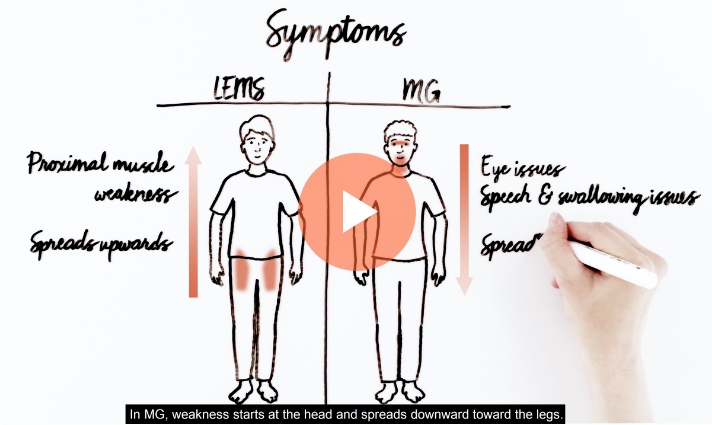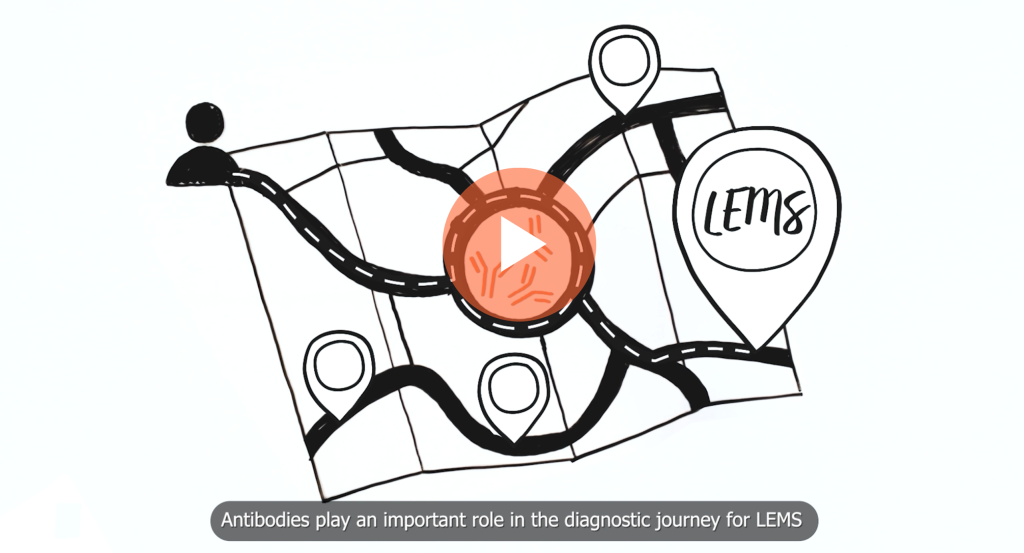

Could It Be LEMS?
Lambert-Eaton myasthenic syndrome (LEMS) can cause symptoms throughout the body
The main symptom of LEMS is muscle weakness, especially in the legs and hips. But LEMS can also weaken muscles in other areas of the body and affect a part of the nervous system that controls automatic bodily functions, such as saliva production, digestion, and arousal.
LEMS Symptoms
LEMS symptom map
- Dizziness upon standing
- Fatigue
- Dry eyes, drooping eyelids, and/or blurred vision
- Dry mouth, difficulty swallowing
- Difficulty raising arms or lifting objects
- Constipation
- Erectile dysfunction
- Upper leg weakness
- Lower leg weakness
Another way to recognize the symptoms of LEMS is to be aware of how they may be interfering with your normal activities. Review this list of everyday activities to see how your symptoms may be affecting your daily life.
Everyday activities that I’m finding harder to do
Walking
Climbing or descending stairs
Getting into or out of a car
Reading or focusing eyes
Getting/maintaining an erection
Talking
Chewing
Swallowing
Using the bathroom
Standing up without
getting dizzy
Raising my arms or lifting
objects
…The next day, i told my husband, i can’t get out of bed.
Signs and symptoms of LEMS
In this video, Desiree describes her journey to an eventual LEMS diagnosis. What started out as severe gastrointestinal issues that required multiple surgeries was soon followed by neurologic events that led to her final diagnosis.
LEMS DIAGNOSTIC CHALLENGES
LEMS is often initially diagnosed as another disorder
If you’ve been researching your symptoms online, you’ve probably discovered that there are several conditions, such as myasthenia gravis (MG), multiple sclerosis (MS), myopathy, and amyotrophic lateral sclerosis (ALS), that can cause muscle weakness and lead to an inaccurate diagnosis the first time a person sees a doctor. As a result, it can take some patients years to receive the correct diagnosis.
The long journey to a diagnosis of LEMS
One study found that it took patients with LEMS an average of
MORE THAN 4 YEARS
to receive a correct diagnosis.
That’s way too long—you’ve got a life to get back to and things to do! That’s why it’s so important to
who knows what to look for.
LEMS is often mistaken for myasthenia gravis (MG)
Like LEMS, MG is a rare neuromuscular disorder that:
Disrupts communication between nerves and muscles
Typically appears during middle adulthood
Causes debilitating muscle weakness
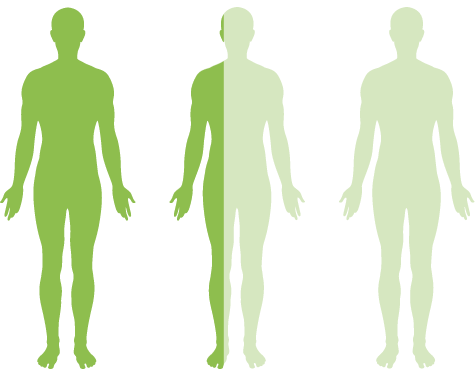
MORE THAN 1/3
of patients with LEMS were first diagnosed with MG.
LEMS and MG share similar signs, but there are several key differences
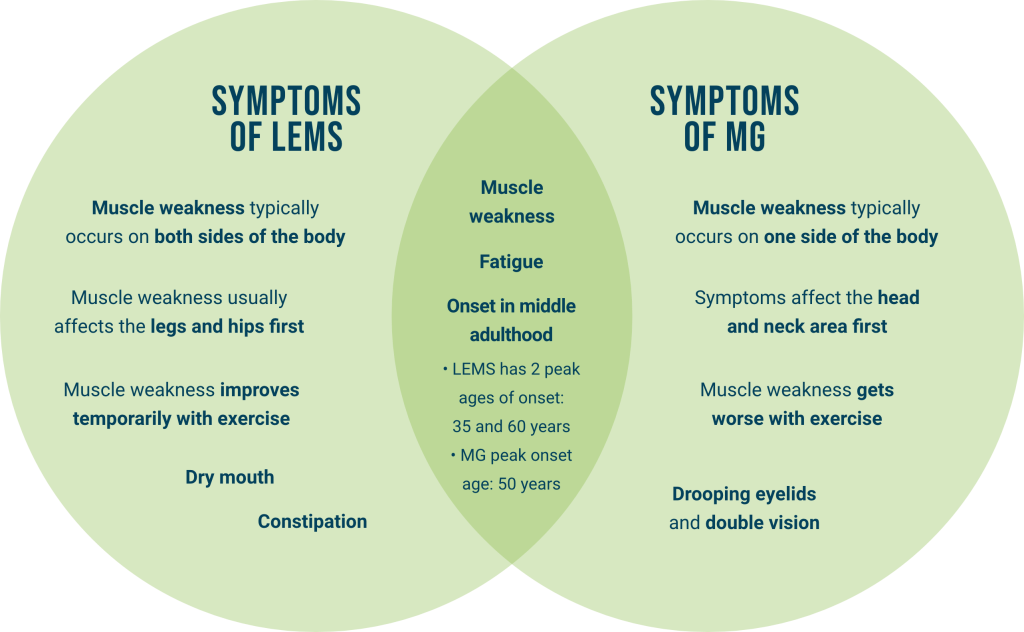
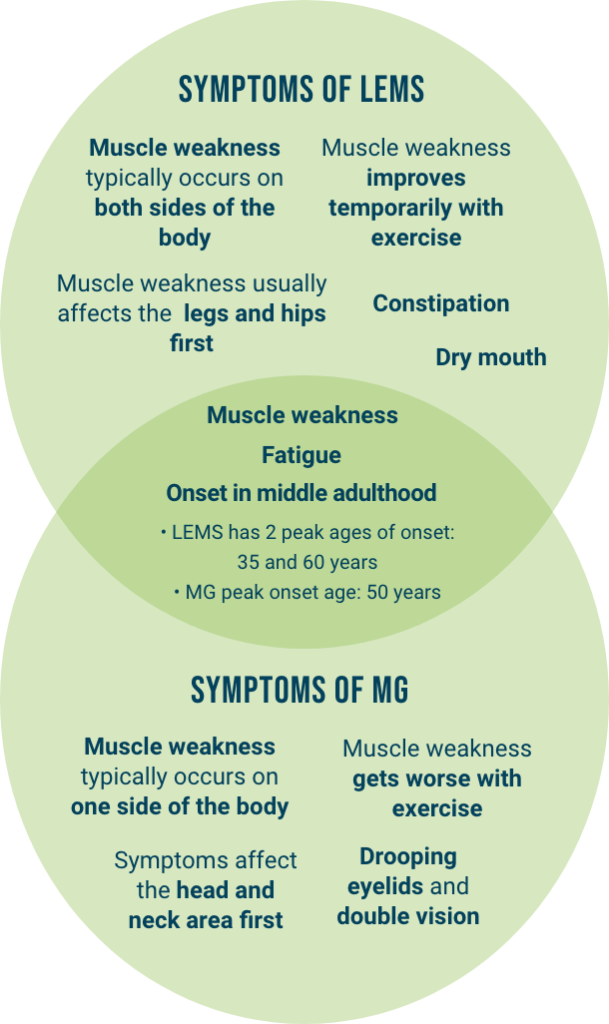
The role of antibodies in LEMS and MG
Both LEMS and MG are neuromuscular disorders that occur when the body’s own immune system mistakenly attacks itself. These attacks occur when special proteins called antibodies target the neuromuscular junction (NMJ)the space where nerves and muscles join and inhibit the secretion of a chemical neurotransmitter called acetylcholine (ACh). Without enough ACh, signals cannot be transmitted between the nerves and muscles. This disruption keeps the muscles from working properly. It is one of the reasons that LEMS and MG are similar.
But, it is also an important way that your doctor can tell LEMS and MG apart,
because each disorder is caused by different antibodies.
LEMS and MG are caused by different antibodies

LEMS is caused by antibodies that target the voltage-gated calcium channels (VGCCs) in the NMJ, so they are referred to as VGCC antibodies. These antibodies don’t allow signals to be sent from the nerves.

MG, in most cases, is caused by antibodies that target the acetylcholine receptors (AChRs) in the NMJ, so they are referred to as AChR antibodies. These antibodies don’t allow signals to be received by the muscles.
Your doctor can use a simple blood test to identify whether you have the antibodies associated with LEMS or those associated with MG. Learn more about this test.

LEARN MORE ABOUT THE SIMILARITIES AND DIFFERENCES BETWEEN LEMS AND MG!
To see what sets these two disorders apart, download the “What’s Behind My Symptoms?” infographic.
Take the next step
Talk to a Doctor
If you’re experiencing symptoms of LEMS and haven’t been diagnosed—or you’ve been diagnosed with MG or another disorder but aren’t satisfied with your response to treatment—talk to a doctor. There are physicians who specialize in diagnosing and treating neuromuscular disorders. They can perform the specific tests that can accurately identify what’s causing your symptoms.
Here are 3 more reasons to strongly pursue an accurate diagnosis:
Feeling better
The sooner you know what’s causing your symptoms, the sooner they can be treated. Take your life off PAUSE! Choose to feel better, starting today.
Maintaining strength
While LEMS is a disease that will continue to progress, studies show that following an effective treatment for LEMS can help you maintain your strength and muscle function.
Uncovering hidden cancer
Historically, more than half of LEMS cases are associated with an underlying cancer.
For some patients, LEMS symptoms are an important early warning sign that may help save their lives.



